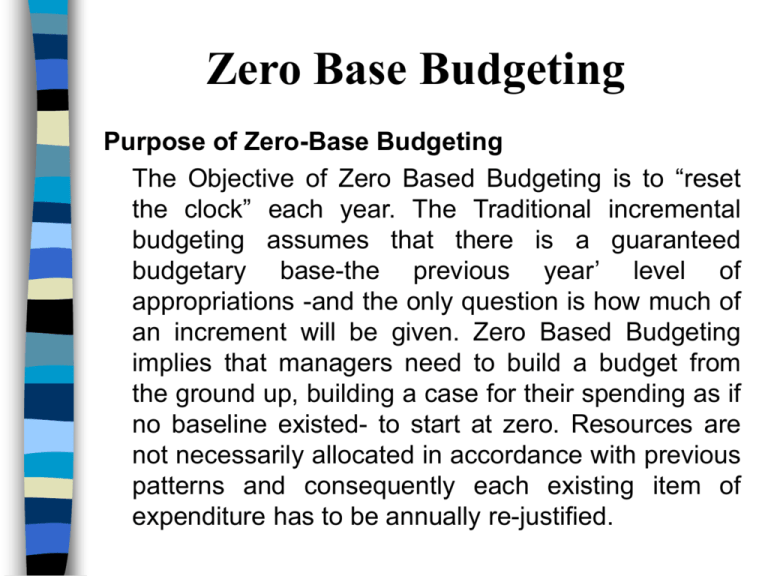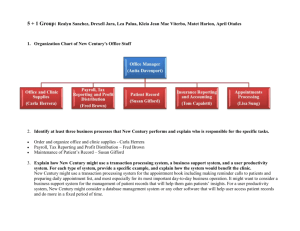Zero Base Budgeting
advertisement

Zero Base Budgeting Purpose of Zero-Base Budgeting The Objective of Zero Based Budgeting is to “reset the clock” each year. The Traditional incremental budgeting assumes that there is a guaranteed budgetary base-the previous year’ level of appropriations -and the only question is how much of an increment will be given. Zero Based Budgeting implies that managers need to build a budget from the ground up, building a case for their spending as if no baseline existed- to start at zero. Resources are not necessarily allocated in accordance with previous patterns and consequently each existing item of expenditure has to be annually re-justified. Put differently, the purpose of ZBB is to reevaluate and reexamine all programs and expenditures for each budgeting cycle by analyzing workload and efficiency measures to determine priorities or alternative levels of funding for each program or expenditure. Through this system, each program is justified in its entirety each time a new budget is developed. Historical development of ZBB ZBB or some modified version of it, has been used in the private- and public -sectors for decades. The first known application of zero-base budgeting was by the U.S Department of Agriculture in 1962. However, the general problem of incremental budgeting that zero-base budgeting attempts to solve has been recognized from a much earlier period. Indeed, the major next application of ZBB in government has been tracked back to GOV. Jimmy Carter’s use of it in Georgia in the early 1970s. In the private sector, the major leap forward occurred with the development at Texas Instruments Inc. of a way to handle the mass of data. This involved the implementation of a “Decision Package” approach to prepare the 1970 budget for the Staff & Research Divisions. Application of ZBB The practical application of ZBB involves the use of the “Decision Package”. All budgetary procedures involve an identification of organizational objectives. In the context of these objectives, ZBB involves three stages: 1. Identification of decision units. 2. Development of decision package. 3. Review and ranking of decision packages. 1) Identification of decision units The existing organization structure identifies the units in the hierarchy for which budgets are prepared. These could responsibility centers, cost centers, profit centers, investment centers, program categories or program elements. This is the starting point for identifying decision units for ZBB. Decision units should have the following characteristics: A specific manager should be clearly responsible for the operation of the program It must have well defined & measurable impacts It must have well defined & measurable objectives. After the identification of appropriate decision units, the next step is to prepare for each of these a document describes the objectives or purposes of the decision unit and the actions that could be taken to achieve them. Such document is called “Decision Package” 2) Development of Decision packages Two types of decision package: A. The mutually exclusive decision package; the purpose here is to identify for each decision unit the alternative ways of performing its functions so as to enable management to choose the best alternative. One such alternative will be to abolish the decision unit and not to perform it functions at all. B. The incremental decision package; Here, each manager identifies different levels of effort ( and associated costs ) and their impact on the function. i.e. there will be a Minimum Level, below which it would be impossible to perform the function; a Base Level, which reflects the current level of activity; and Improvement Level, which shows the effect of increases over the current level. 3) Review and Ranking of decision Package Once the decision packages have been prepared, they are ranked on an ordinal scale i.e 1st, 2nd, 3rd, etc.in order of priority. In situation where a “bottom-up” approach and due to large number of decision packages,the ranking process would take place at a number of levels. How would you choose the decision units? Answer: Suppose you are the chief executive of a local authority, and there are 5 departments under your responsibility and you ask the manager in charge of Educational Department to adopt the ZBB. Using the educational service as an example, first the decision units could be at any of the following levels: * the service level, with the whole of the education service being one decision unit, the whole of highway service being one decision units,& so on; * the ‘division of service’ level, which for education would mean the whole of primary education being one decision unit, the whole of secondary education being one decision unit, & so on; * the subdivision of service level, which would mean that each school would be one decision unit; or * the school department level, with each department, such as history or physics, being one decision unit. In connection with this, one scholarly writer stresses that: “Agencies should ensure that the basic decision units selected are not so low in the structure as to result in excessive paperwork and review. On the other hand, the units selected should not be so high as to mask important considerations and prevent meaningful review of the work being performed” With regards to decision package, the intention is to identify alternative ways of performing the functions of a decision unit and to determine the effect of different levels of effort on each alternative. Some experts suggest that in practice “it is adequate first to select the best alternative from among the mutually exclusive decision packages, and then to use this as the basis for the incremental decision package analysis”. ( illustration Figure 5.3 p 93 ). Example of a decision package: Figure 5.5 p 96 shows how a decision package might look in practice. This a hypothetical example for the mathematics department of a secondary school and show in detail the D.P document for the existing (base) level of effort for the next year. This is package 1 of 3. • We can now return to the point we made earlier about the importance of striking the correct balance when determining the level of decision unit. If in this example we select the whole secondary school as the decision unit, then important considerations might be ignored. i.e. the quantitative package measures might well be the total number of GCSE examination passes for the whole school so that the incremental package would merely represent overall changes rather than the changes relating to specific subjects. This is obviously less useful for decision making because the issue would tend to be one of the need for the school rather than the need for a mathematics department within the school. Review and ranking of decision making Once the decision packages for the various levels in an organization are prepared, the decision packages are ranked on an ordinal scale( i.e. 1st, 2nd, 3rd, etc ) In a situation where a ‘bottom-up’ approach to budget determination in the education service existed, there would be a large number of decision packages and therefore ranking process would take at a number of levels. In our example, Figure 5.5 p 96, the decision units are at the level of various departments ( i.e. Mathematics, English, Science, and so on ) and therefore the lowest level at which the decision packages from these departments would be ranked would be the whole school. The next stage in the ranking process would involve the consolidation at a higher level of all the lowerlevel rankings. Following from figure 5.1 p 91, this would mean that the consolidation of the decision packages rankings will take place at many levels. When faced with many different decision packages the ranking exercise is not straightforward. The process is inherently political and the ranking of decision at each level of consolidation to be taken by a special committee and usually is determined by a system of voting. To facilitate the ranking, criteria should be developed and enforced such as: 1. whether the activity is specifically required by law; 2. Whether the organization has the resources and technical skills to implement the activity; 3. Whether the package is cost-effective; 4. Whether the package will be politically acceptable. Weights can then be attached to each criterion, and the result of the weightings will form the basis of the ranking exercise. Because each decision package would be considered at every consolidation level, this would involve an enormous administrative burden. One approach that has been proposed to reduce the burden is through the use of ‘cut – off’ points at each level of consolidation. i.e at the first consolidation level a cut-off point of say, 75 per cent of the total budget request for that level might be applied, so that only those packages falling below this cut-off point would be reviewed and ranked at the next consolidation level. Strengths of ZBB ZBB unlike incremental traditional line item budget, it dose not assume that last year’s allocation of resources is necessarily appropriate for the current year, all the functions of an organization are reevaluated annually from a zero base. The systematic nature of such a fundamental review imposes a discipline on the organization which has produced in practice secondary advantages; It produces in a readily accessible form more and better management information. This in turn will improve the quality of management’s decision. Another advantage that stems from this improved management information is that its production involves the participation of lower - level management in the budgetary process, and the smaller the decision units, the greater this involvement will become. Unexpected events that occur during the financial year can be more readily adjusted for. This is because the basic information for modifying goals has already been generated. If implemented well, ZBB can eliminate a sense of “entitlement” to cost increases. Improved discipline in developing budgets. More meaningful budget discussions during plan review sessions. Weaknesses of ZBB ZBB vastly overestimates man’s ability to calculate. In practice the effects of different levels of effort on each alternative mutually exclusive decision package are not considered, due to the short budgetary cycle and the need for expediency. But this might lead to a sub-optimal allocation of resources. By incorporating performance measures in the formation of decision packages, it forces managers to establish a preference for effectiveness, efficiency, or equity as they try to rank decision packages. This make the ranking process difficult. The use of cutoff point for packages is different in public agencies. As a result, when funds become tight, even in ZBB systems, each department is asked to make marginal reductions, rather than eliminate the lowest ranked programs. The implementation of a ZBB system requires a great deal of time on the part of agency staff, limiting their ability to perform other important functions. Attempts by agencies to manipulate priority listings by ranking popular items lower than items that would have little chance of funding. Established programs have political support and they will continue to receive their share of the budget regardless of any analysis produced.










